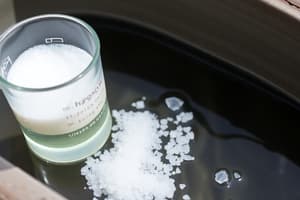Podcast
Questions and Answers
How are total dissolved solids determined?
How are total dissolved solids determined?
- By measuring the weight of all solids and dividing it by the volume of the sample.
- By igniting the preweighed evaporating dish in a muffle furnace.
- By filtering out the suspended solids and evaporating the filtrate in a drying oven. (correct)
- By filtering the sample and then trapping the solids on a preweighed filter.
What is the method used to determine volatile solids?
What is the method used to determine volatile solids?
- Measuring the weight of all solids and dividing it by the volume of the sample.
- Evaporating the filtrate in a drying oven after filtering out suspended solids.
- Igniting the solids in a muffle furnace and dividing the weight loss by the volume of sample. (correct)
- Filtering the sample and trapping the solids on a preweighed filter.
What is the process for determining total solids?
What is the process for determining total solids?
- Evaporating the filtrate in a drying oven after filtering out suspended solids.
- Filtering the sample and trapping solids on a preweighed filter.
- Measuring the weight of all solids, evaporating, and dividing by sample volume. (correct)
- Iginiting the preweighed evaporating dish in a muffle furnace.
How are suspended solids separated for analysis?
How are suspended solids separated for analysis?
What happens to the weight gain of the filter when determining suspended solids?
What happens to the weight gain of the filter when determining suspended solids?
Why are total dissolved solids measured after filtering out suspended solids?
Why are total dissolved solids measured after filtering out suspended solids?
What is the purpose of determining settleable solids in wastewater analysis?
What is the purpose of determining settleable solids in wastewater analysis?
In wastewater analysis, how are settleable solids typically measured?
In wastewater analysis, how are settleable solids typically measured?
What is the purpose of a gravimetric procedure in chemical analysis?
What is the purpose of a gravimetric procedure in chemical analysis?
In percent composition analysis, what does the term 'percent of P in the sample' refer to?
In percent composition analysis, what does the term 'percent of P in the sample' refer to?
How is settleable solids content determined from total solids in wastewater analysis?
How is settleable solids content determined from total solids in wastewater analysis?
What is the main purpose of precipitating phosphorus as Mg2P2O7 in chemical analysis?
What is the main purpose of precipitating phosphorus as Mg2P2O7 in chemical analysis?
What is used as the titrant in a redox titration involving iodometry?
What is used as the titrant in a redox titration involving iodometry?
Which of the following is NOT a primary standard oxidizing agent for redox titration using iodometry?
Which of the following is NOT a primary standard oxidizing agent for redox titration using iodometry?
What color does the indicator starch turn when mixed with iodine in a redox titration using iodometry?
What color does the indicator starch turn when mixed with iodine in a redox titration using iodometry?
Why should the starch solution not be added until the end point is near in a redox titration using iodometry?
Why should the starch solution not be added until the end point is near in a redox titration using iodometry?
At what temperature limit should starch not be used as an indicator in redox titration involving iodometry?
At what temperature limit should starch not be used as an indicator in redox titration involving iodometry?
Flashcards are hidden until you start studying
Study Notes
Measuring Solids in Water and Wastewater
- Total solids are measured by evaporating a volume of water or wastewater in a preweighed evaporating dish and weighing the residue, with the result expressed in milligrams per liter (mg/L).
- Suspended solids are measured by trapping them on a preweighed filter, drying, and weighing the filter, with the result also expressed in mg/L.
Total Dissolved Solids
- Total dissolved solids are calculated by subtracting suspended solids from total solids.
- They are measured by filtering out suspended solids, evaporating the filtrate, and weighing the residue.
Volatile Solids
- Volatile solids are measured by igniting the residue or filter in a muffle furnace and calculating the weight loss, with the result expressed in mg/L.
Settleable Solids
- Settleable solids are measured by allowing suspended solids to settle for a specified time and then measuring the solids in the settled sample, with the result expressed in mg/L.
- They are calculated by subtracting the settleable solids from the total solids.
Example of Suspended Solids Measurement
- A sample of lake water was tested for suspended solids, with a volume of 100.00 mL and a filter weight of 0.1028 g before filtering and 0.3837 g after filtering, resulting in 2809 mg/L of suspended solids.
Gravimetric Procedure
- A gravimetric procedure involves converting an analyte to a chemical form that can be separated and weighed accurately using a gravimetric factor.
- Gravimetric factor is calculated as AW / (MW * Q), where AW is atomic weight, MW is molecular weight, and Q is the balancing coefficient.
Example of Phosphorus Analysis
- A sample weighing 0.8112 g was analyzed for phosphorus content by precipitating phosphorus as Mg2P2O7, resulting in a precipitate weight of 0.5261 g, and a phosphorus content of 354.2 ppm.
Redox Titration - Iodometry
- Redox titration involves indirectly measuring an oxidizing agent by titrating the iodine formed in the reaction with sodium thiosulfate (Na2S2O3).
- Common primary standard oxidizing agents include potassium dichromate (K2Cr2O7), potassium bromate (KBrO3), and potassium iodate (KIO3).
Indicator in Iodometry
- Starch is used as an indicator in iodometry, forming a deep blue color with iodine and becoming colorless at the end point.
- Starch solution should be fresh, added near the end point, and not used in strong acid solutions or at temperatures above 40°C.
Studying That Suits You
Use AI to generate personalized quizzes and flashcards to suit your learning preferences.




